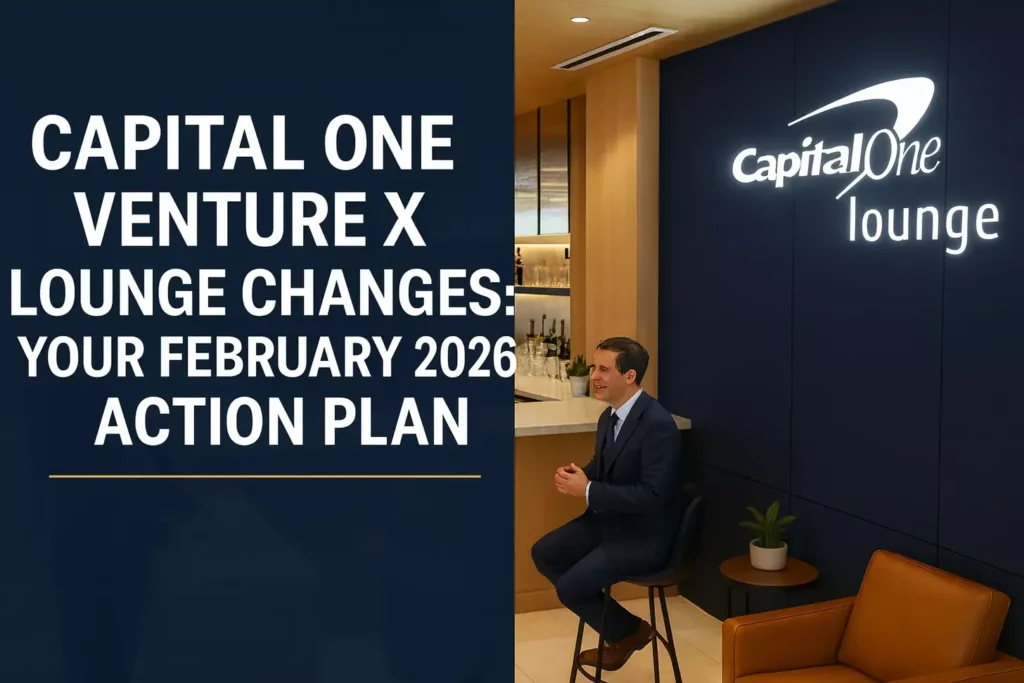Affiliate Disclosure: Award Travel Hub may earn a commission or referral bonus from some links on this site. These affiliate links help support our work and may influence the placement or promotion of certain products or services. However, our content is independently crafted to reflect honest opinions. Not all offers or products are included. There is no additional cost to users when they utilize our affiliate links.
Surprising fact: more than 60% of cardholders who use airport lounges travel with at least one guest — and that behavior faces a big cost shift on Feb. 1.
We outline what shifts and what stays so you can make quick, practical choices. Primary cardholders keep their own access to Capital One Lounges, Landings, and Priority Pass, but complimentary guest rules tighten. Authorized users lose free access unless the primary adds an AU lounge add-on for $125 a year.
Guest fees and a $75,000 annual spend threshold change the math for many travelers. We’ll show when to pay per visit, when to add paid AU access, and when the high spend path could make sense. We also compare alternatives and highlight remaining perks—like the $300 travel credit, anniversary miles, and travel protections—that help preserve card value while you reassess.
Key Takeaways
- Primary accounts keep personal access; guest access becomes mostly paid.
- Authorized users lose free entry unless the AU add-on is purchased.
- Guest fees and a $75,000 spend threshold can restore limited complimentary guests.
- Venture X Business keeps two complimentary Priority Pass guests for primaries.
- Use travel credits and anniversary miles now while you plan your next moves.
Capital One lounge access is changing in 2026: what’s new, what stays, what it costs
We break down the new rules and costs so you can decide whether to pay per visit, add authorized users, or chase a high-spend unlock.
Effective Feb. 1, 2026: complimentary guest access and free authorized user lounge access end.
What changes on the effective date
Primary cardholders keep their own access to Capital One lounges, Capital One landings, and Priority Pass lounges. However, in many cases, guests no longer ride for free.
At Capital One locations, admission costs $45 per adult and $25 for children aged 2–17; children under 2 are admitted free. Priority Pass lounges will switch to a $35 per guest per visit fee for personal accounts.
What can restore limited complimentary access?
Hit $75,000 in a calendar year, and you unlock two guests at Lounges and one at Landings for the rest of that year and the next.
Authorized users lose automatic entry, though you can add AU lounge access for $125 per AU to restore access across networks.

“We recommend modeling per-visit fees versus AU add-ons before the change so you know the most cost-effective choice for your household.”
- Primary access remains, preserving core lounge access even as guest rules tighten.
- Venture X Business primarily still keeps two complimentary Priority Pass guests; paid AU rules differ for business accounts.
- Plan now: complimentary access continues through January 31, so act before the calendar flips.
Capital One Venture X Lounge Changes: Your February 2026 Action Plan
We map the new guest rules so you can choose the cheapest path for companions and kids.

New per-visit pricing
Capital One Lounges and Capital One Landings move to $45 per adult and $25 for ages 2–17; under 2 remains free. At personal accounts, Priority Pass lounges no longer allow complimentary guests—budget $35 per guest per visit.
Authorized users vs paying per visit
Authorized users lose automatic entry, but you can add lounge access for $125 per AU annually. For a frequent partner who flies three to five times a year, the AU add-on often saves money versus repeated guest fees.
| Scenario | Per-visit cost | AU add-on | Best choice |
|---|---|---|---|
| Partner, 3 trips/yr | $45 × 3 = $135 | $125/yr | AU add-on |
| Occasional friend, 1 trip/yr | $45 | $125/yr | Pay per visit |
| Child (age 2–17), 4 trips/yr | $25 × 4 = $100 | $125/yr | Pay per visit (usually) |
When spending restores limited guests
Hit spend 75,000 in a calendar year, and you unlock two complimentary guests at Capital One lounges and one at landings for the remainder of that year and the next.
- That unlock does not restore complimentary guests at priority pass lounges for personal cards.
- We recommend tracking progress mid-year so you can make adjustments before the calendar year closes.
“Model your likely visits, multiply by guest fees, and compare to the AU add-on to pick the lowest-cost option.”
Venture X Business: How owners should adapt guest and authorized user access
For business owners, policy tweaks change how teams access airport lounges and how costs stack up. We outline simple steps to protect team travel benefits and control spend.
Priority Pass advantage: the primary business cardholder will still be able to bring two guests into Priority Pass lounges. That keeps a key team perk intact for meetings and executive travel.
Equip frequent travelers
Authorized users can be added for lounge access at $125 each. You may add up to four additional cardholders. Each AU receives their own Priority Pass and can bring two guests.
When to chase high spend
If your routes hit DFW, DCA, DEN, or future locations, aim to spend $75,000 in a calendar year to restore two guests at one lounge and one guest at one landing for the remainder of that year and the next.
| Use case | Typical annual visits | Best option |
|---|---|---|
| Road warrior | 3–6 visits | AU access ($125) |
| Occasional staff | 1 visit | Pay per guest fee |
| Team meetings | 4–8 visits | Two AUs or target spend 75,000 |
“Assign AU access to frequent flyers and use per-visit fees for occasional travelers to keep costs predictable.”
- Centralize card issuance and set a clear lounge access policy.
- Review the pass lounge usage quarterly to confirm the access fee returns value.
- Document who is able to bring guests to avoid misuse and surprise charges.
Should you switch cards? Comparing Chase Sapphire Reserve®, American Express, and other lounge paths
Choosing a new premium card hinges on where you fly, who you bring, and how often you need reliable lounge access. We compare the major ecosystems so you can make an informed decision quickly.
Chase Sapphire Reserve®
Chase Sapphire Reserve® includes Priority Pass with the ability to bring two guests and access to Chase Sapphire Lounges by The Club. The card carries a $795 annual fee and $195 per AU, but the flexible $300 travel credit adds real value.
American Express Platinum
American Express offers Centurion access, plus Plaza Premium and Escape partners. Guest rules tightened; AU fees apply. This path suits solo travelers or high spenders who value premium Centurion spaces.
Ritz‑Carlton Card and airport focus
The Ritz‑Carlton Card can be family-friendly: unlimited authorized users and generous Priority Pass guesting. For DEN, DFW, DCA, JFK, LGA, IAD, LAS, pick the network that serves those airports best.
| Card | Key perk | Best for |
|---|---|---|
| Chase Sapphire Reserve® | Priority Pass + bring two, Maple Leaf access | Companions, flexible credit |
| American Express Platinum | Centurion, Plaza Premium | Solo premium seekers |
| Ritz‑Carlton Card | Unlimited AUs, generous PP guests | Families |
“Test lounges on trips before switching — real use reveals whether access and guest policies match your travel.”
Maximize the remaining Venture X value before and after February 2026
Timing and small moves can preserve big value from rewards and portal credits even as guest rules tighten.
Use the $300 travel coupon carefully
The $300 Capital One Travel credit now works like a coupon inside the portal. That means refunds and insurance triggers can change if a booking is canceled after the credit applies.
We recommend using it on refundable hotel rates or prepaid car rentals booked early. That reduces the chance that a canceled trip leaves you with a stranded coupon value.
Lock in recurring perks and protections
Don’t forget the annual 10,000 anniversary miles and up to $120 in Trusted Traveler credits every four years.
Switch a phone bill to the card to enable cell phone protection, but confirm your carrier accepts the card before you change billing.
Earning and when to use the portal vs partners
The card earns 2x everywhere, and transfer partners often beat the portal for premium cabins.
Use the portal for simple domestic bookings when cash rates are competitive. Transfer miles for upgrades or complex itineraries.
- Track progress toward the $75,000 calendar year threshold if complimentary guests matter.
- Family tip: one AU with the $125 add-on plus occasional per-visit guest fees can be cost‑efficient.
- Audit lounge, lounge usage, and guests’ costs quarterly to justify the annual fee.
“Model refundable bookings and transfer values now so you don’t leave credit or miles on the table.”
We’ll revisit decisions if home‑airport access shifts or a competing issuer offers better Priority Pass lounges or partner coverage.
Keep, downgrade, or cancel: timing and steps to protect your rewards
Before you act, a few timed steps can protect credits, miles, and account age. We walk through when to downgrade, when to cancel, and a short pre-exit checklist.
Annual fee and calendar-year mechanics
Timing matters. Downgrade before the annual fee posts to avoid the charge. If the fee posts, you usually have about 30 days to request a refund.
Consider calendar-year goals: hitting the $75,000 threshold can help you retain limited guests and determine whether you keep the card throughout the year.
Pre-exit checklist
- Use the $300 travel credit inside the portal before leaving.
- Apply Trusted Traveler credits and download receipts for records.
- Pool or transfer venture rewards to a partner account to avoid orphaned miles.
- Adjust automatic payments on the card so services don’t get interrupted.
- Decide on authorized user access — authorized users lose complimentary entry, or you can pay 125 per AU to retain access.
| Choice | Why | When to choose |
|---|---|---|
| Keep | Solo access + credits net positive | Need lounge access and travel credits |
| Downgrade to VentureOne | Preserve miles and account age, $0 annual fee | Prefer transfer partners without fee |
| Cancel | Overlap with better rewards credit card | Costs exceed value |
“Keep if solo access plus credits outweigh the annual fee; downgrade to save history; cancel when another card gives better lounge outcomes.”
Conclusion
This closing summary gives clear steps to protect perks and control lounge spending.
Core shifts are straightforward: fewer complimentary access guests, new guest fees, and authorized users moving to a paid add‑on. Your personal access remains intact, and business primaries keep a useful priority pass for guests’ advantage.
Decide by modeling three paths: pay per visit, add AU access for frequent companions, or chase the $75,000 spend threshold to restore limited complimentary access at Capital One lounges and Capital One landings. If guests’ priority pass access is key, consider alternatives like the Chase Sapphire Reserve, American Express Platinum, or the Ritz-Carlton Card.
Next steps: check which pass lounges you use most, use the $300 portal rewards credit, bank anniversary miles, and compare per‑visit fees vs AU add‑on costs. If you usually travel solo, keeping the card still often pays. If companions travel frequently, consider model costs and switching cards.
Revisit this plan each year as networks, lounge access fee rules, and routes change, so your card choice continues to match real travel needs.



